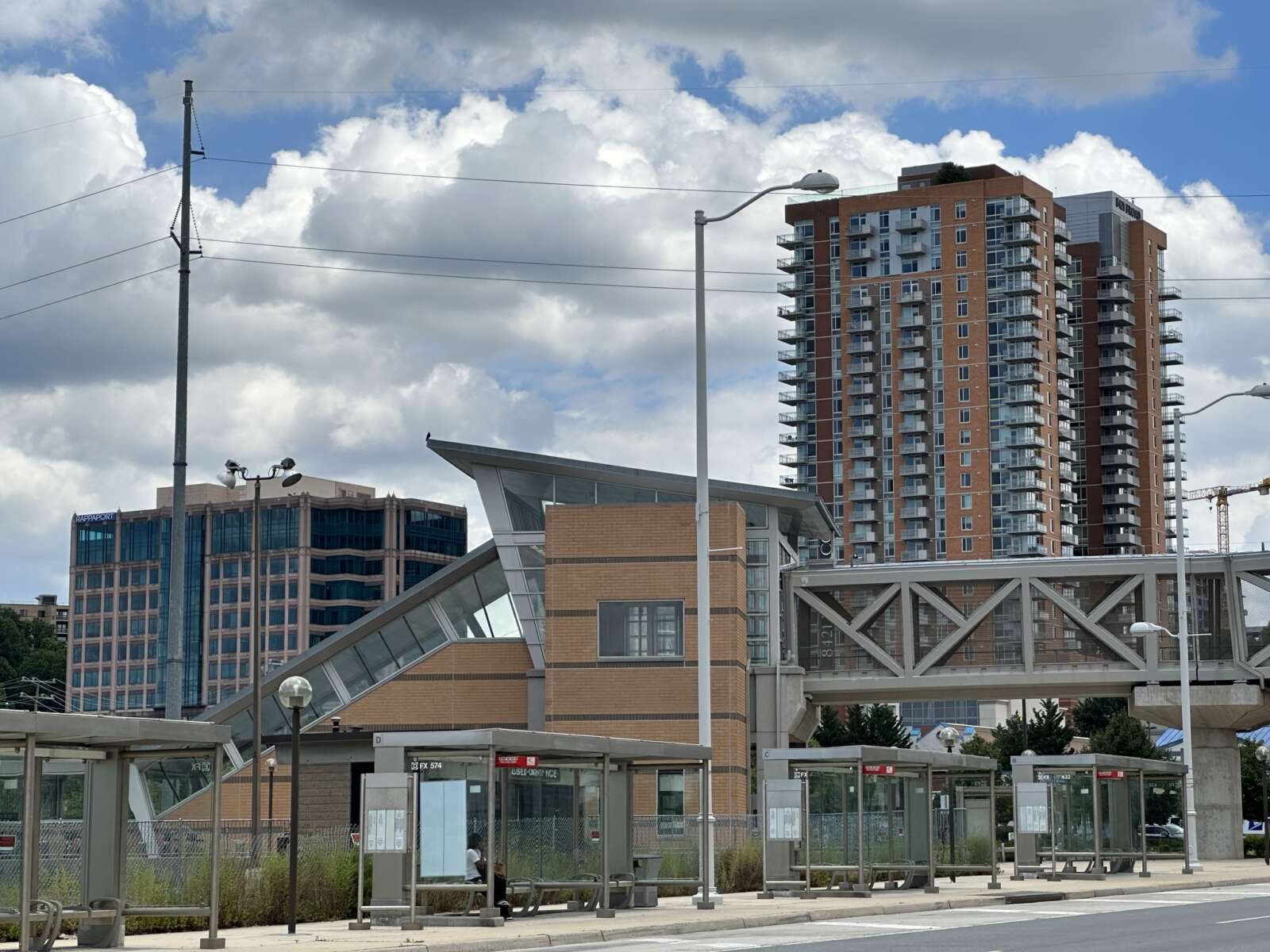
(Updated at 9:25 a.m. on 12/15/2023) The long-running effort to bring bus rapid transit (BRT) service to Route 7 is about to enter a new stage of planning, but for some Fairfax County leaders, the milestone doubles as a reminder of how much more still needs to be done to turn Northern Virginia’s vision into a reality.
The Fairfax County Board of Supervisors approved an agreement at its Dec. 5 meeting to help fund an engineering study and environmental analysis required to implement the bus system, which will serve the corridor from the Spring Hill Metro station in Tysons to the Mark Center in Alexandria.
Though they voted 9-1 in support of the agreement, some board members raised concerns about a lack of clarity on the project timeline from the Northern Virginia Transportation Commission, the regional organization that’s managing the planning process.
“I sit on NVTC, and I don’t have a comfort level yet that they have their hands wrapped around this,” Dranesville District Supervisor John Foust said. “Constantly, I’m asking for schedules — when is this going to happen? — and they never provide them.”
Foust — whose district includes the West Falls Church Metro area at the southern end of the BRT’s future Tysons segment — called NVTC a “great organization” and voted for the agreement, which was only opposed by Springfield District Supervisor Pat Herrity.
But Foust urged county and NVTC staff to provide a thorough breakdown of the long-range plan for the project known as Envision Route 7, including an estimate of when it would be completed “if everything goes as anticipated.”
“That would be very helpful, I think, in evaluating each step as we go forward,” he said.
Board of Supervisors Chairman Jeff McKay concurred, adding that the county doesn’t need specific dates but would find it “helpful” to get a more detailed timeline of key milestones to expect going forward.
He noted that NVTC has already been working on the dedicated Route 7 bus system for years, dating back to a transit study commissioned in 2013.
“The number one question I’ve had about this is, ‘What has been taking so long to get to this point and what does the future look like?'” McKay said. “What we do know is this will be a long-term project, but we need to have a reasonable understanding of what that means in terms of years.”
Fairfax County Department of Transportation acting director Gregg Steverson confirmed the request was “something we can provide to you.”
(Correction: This story initially misidentified Gregg Steverson as the NVTC acting director.) Read More
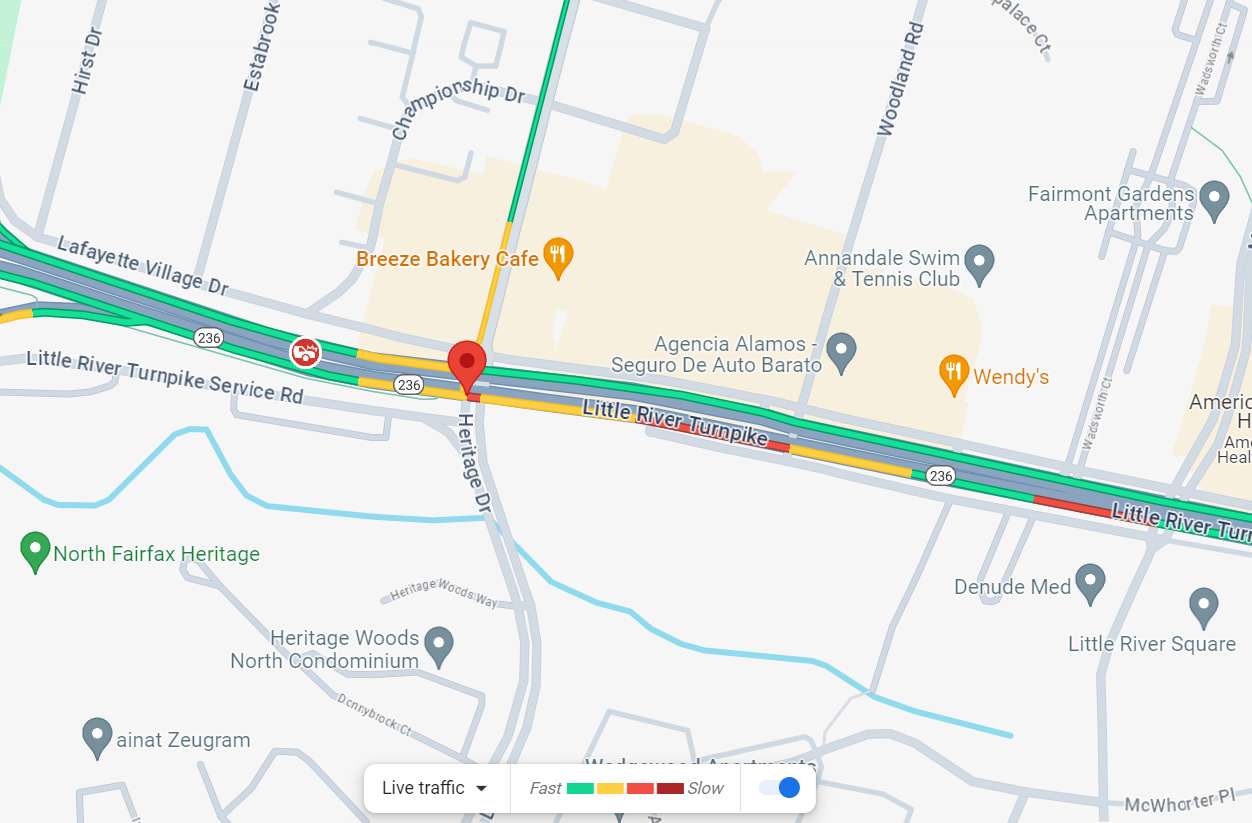
A woman suffered serious injuries earlier this evening (Monday) when she was apparently hit by a Metrobus on Little River Turnpike.
“Officers are investigating a bus crash involving a pedestrian that occurred on Little River [Turnpike] and Hummer [Road] in Annandale,” the Fairfax County Police Department said. “The pedestrian, an adult female, was transported in life-threatening condition.”
Eastbound Little River Turnpike was shut down at Hummer.
First responders were dispatched to that intersection for the crash just before 10 p.m., according to scanner traffic on Open MHz. When police and Fairfax County Fire and Rescue Department units arrived, the woman was found trapped under the front wheels of the bus.
“It does look like we’ve got one patient with severe head wounds. She is alert and conscious right now,” an FCFRD responder said at 10:04 p.m.
The fire department responder in command reported at 10:10 p.m. that the trapped woman was a pedestrian and the vehicle was a Metrobus.
Metro didn’t immediately respond to a request for comment.
The woman was transported to Inova Fairfax Hospital with serious injuries. No passengers were on the bus, per the scanner.
Officers are investigating a bus crash involving a pedestrian that occurred on Little River Trpk and Hummer Rd in Annandale. The pedestrian, an adult female, was transported in life-threatening condition. EB Little River Trpk is closed at Hummer Rd. Please avoid the area #FCPD pic.twitter.com/QSivOK6VHa
— Fairfax County Police (@FairfaxCountyPD) December 5, 2023
WOMAN RUNOVER AND TRAPPED UNDER METROBUS— Little River Turnpike at Hummer Rd in Annandale. She was last reported conscious but with a severe head injury. She is under the front axle. Heavy-duty wreckers req'd to assist with rescue. #VATraffic #WMATA @MetroGuns pic.twitter.com/FwrdV2VczQ
— Alan Henney (@alanhenney) December 5, 2023
Map via Google Maps
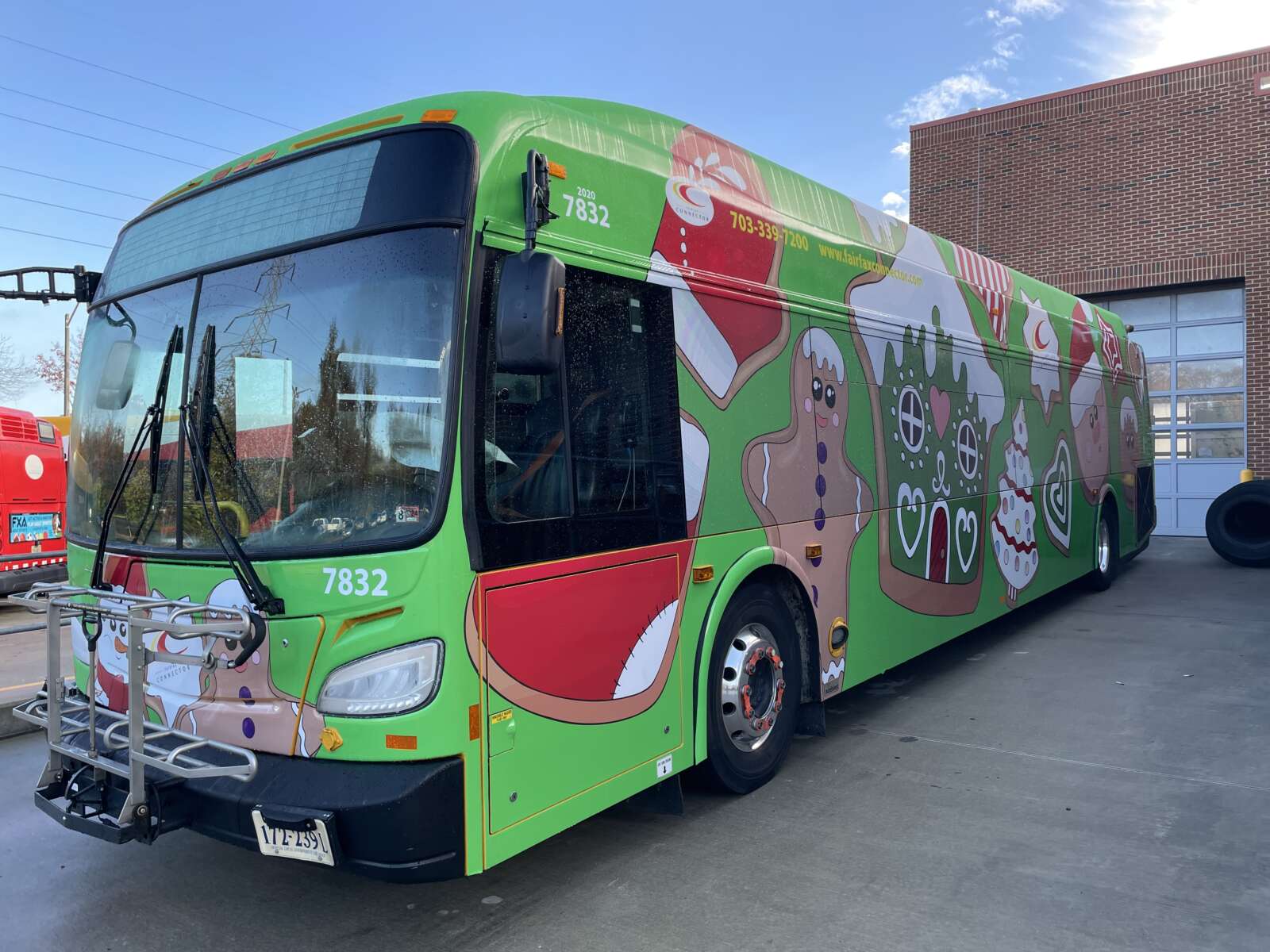
Fairfax Connector will pull into the Fairfax County Government Center soon for its first-ever Winterfest.
Space is quickly disappearing for the public bus system’s holiday event, which will take place from 10 a.m. to 3 p.m. on Saturday, Dec. 9 in parking lot B of the government center (12000 Government Center Parkway).
Featuring three holiday-themed buses, free food and other treats, Winterfest is free to attend, but a general admission ticket is required for entry. As of this afternoon (Wednesday), more than half of the 500 available slots had been taken, according to the sign-up page.
Separate tickets for a planned Santa Bus, where visitors can meet jolly St. Nick, sold out within hours of going online, a Fairfax County Department of Transportation spokesperson says. In response to the demand, a second bus where attendees can get a free cookie from Mrs. Claus has been added.
Access to the “Cookies with Mrs. Claus” bus is included with general admission.
Winterfest will also feature free hot chocolate and kettle corn, games, music, a “Letters to Santa” station, and Duck donuts and Grill Cheese food trucks. Fairfax Connector will hand out coupons for free rides and other “goodies” throughout the event, according to a news release.
Following in the tracks of Metro, which has decorated a train and buses to resemble gingerbread houses, Fairfax Connector’s holiday buses hit the road earlier this week. They’re wrapped in plaid Christmas tree, Santa gnome and cookie designs.
“These buses are sure to bring a smile to your face,” the news release said. “If you spot one, safely take a picture and share with us on Facebook or Twitter. Use the hashtag #HolidayBus or #FairfaxConnector.”
People who share a photo of the buses on social media will be entered into a drawing for a $50 SmarTrip card, which can be used for Connector buses as well as Metro, Fairfax CUE buses and other local transit systems. The winner will be announced the week of Jan. 1, 2024.
During Winterfest, the tree-decorated bus will serve as the Santa bus, while Mrs. Claus will be in the cookie bus. The gnome bus will host a Stuff-a-Bus donation drive.
“To support our community, Fairfax County Department of Transportation, Fairfax Connector & Transdev are collecting new, unwrapped toys and coats for children ages 5 to 10 years old,” FCDOT said in its news release. “…The toys and coats collected will be delivered to children at three Fairfax County public schools the week of December 11, 2023.”
In a separate charitable effort, today (Thursday) marks the last day of Fairfax County’s virtual Stuff the Bus campaign, which encourages community members to make monetary donations to local nonprofits that provide food assistance.

Fairfax Connector’s operator and workers remain far apart in their negotiations for a new labor contract, says the union representing drivers and other employees of Northern Virginia’s largest public bus system.
Amalgamated Transit Union (ATU) Local 689 accused contractor Transdev of “clearly not [being] serious about bargaining in good faith” in a strongly worded statement issued last Wednesday (Nov. 22), just before Thanksgiving.
Representing 546 employees of Fairfax Connector, which serves about 26,000 daily passengers across 93 different routes, the union confirmed that it got Transdev’s latest contract offer a day earlier. Exact details of the proposal weren’t shared, but the union says workers would still be paid “well below other transit workers” in the D.C. area.
“Transdev’s latest wage offer was a slap in the face since its insulting lowball offer is contingent on the Union withdrawing all of its other economic proposals which include better sick leave, reduced healthcare costs, and retirement security,” ATU Local 689 said in its statement.
The union also claimed that Transdev has “continuously dragged their feet” when responding to requests for meeting dates since the collective bargaining process began in October.
Transdev, a French company that took over Fairfax Connector’s operations and maintenance in 2019, disputed the union’s characterization of the ongoing contract talks, stating that it’s “committed to continuing negotiations in good faith.”
“We value our partnership with the ATU and remain hopeful that we can come to a mutually-agreeable resolution quickly,” a Transdev spokesperson said by email. “We have mutually agreed with ATU to schedule our next bargaining session on 12/1.”
The Dec. 1 bargaining session will come after the existing, five-year contract expires on Nov. 30 at 11:59 p.m.
According to Local 689 spokesperson Ben Lynn, both sides will continue to operate under the current contract even after it expires. Determining worker pay, benefits, working conditions and other issues, the contract was secured in early 2020 after a four-day strike upended bus service throughout the county.
The union could call for a strike authorization vote at any time, but Lynn says nothing has been scheduled so far.
Transdev says it doesn’t anticipate any service disruptions as a result of the agreement expiring.
In its statement, ATU Local 689 said it has “reached tentative agreements on a variety of issues,” but on several of its top concerns, which include wage increases, improved sick leave, retirement security and standardized schedules, the union has been met with “abysmally low numbers” or outright rejection.
“Local 689 members worked on the front line throughout the pandemic to move thousands of people every day across the region,” the union said. “Transdev’s employees deserve to have their dedication and hardwork respected by the company. They have refused to offer a realistic economic proposal that would account for the intense economic pressures impacting its employees over the past three years while continuing to profit off the backs of their workers.”
Fairfax Connector’s labor negotiations come at a challenging time for public transit in the D.C. area, as Metro faces a potential $750 million budget gap and declining fare revenue even as ridership starts to bounce back after the COVID-19 pandemic.
Without significant additional funding, the Washington Metropolitan Area Transit Authority said in October that it could be forced to drastically reduce rail and bus service starting July 2024, raise fares and lay off up to 4,700 workers.
ATU Local 689, which also represents Metro workers, warned WMATA against “balancing Metro’s budget on the backs of workers,” arguing that cutting service levels and worker compensation “simply will not solve the systemic funding issues plaguing” the transit agency.
According to Axios DC, Metro General Manager and CEO Randy Clarke will present an official budget proposal to the agency’s board of directors on Dec. 14.
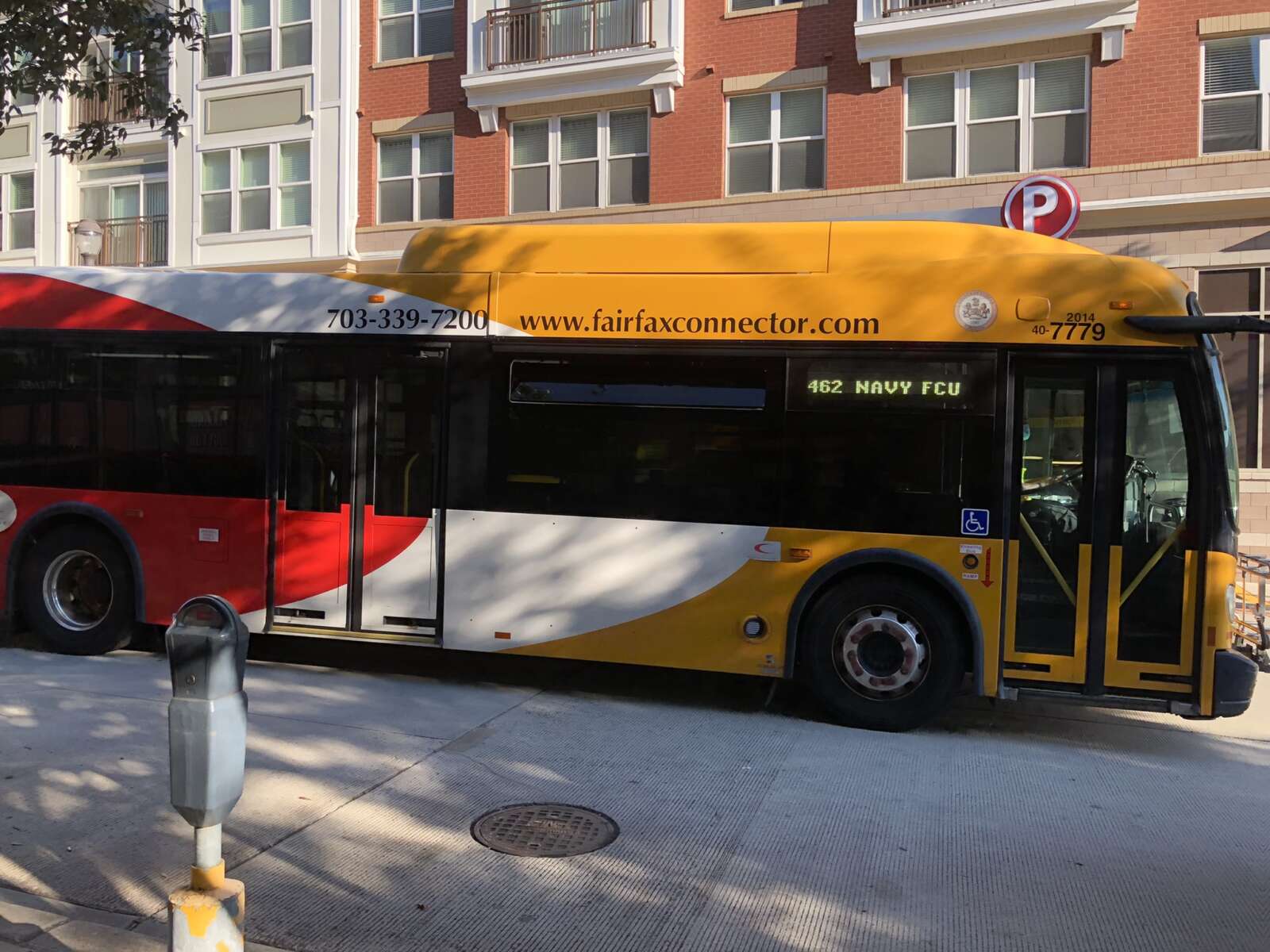
Negotiations over pay, benefits and working conditions are underway for hundreds of Fairfax Connector employees.
Amalgamated Transit Union Local 689 presented an initial proposal on Oct. 13 for a contract that would cover 546 members who work for Fairfax County’s bus system to Transdev, the company that operates the transit service, the union said in a press release yesterday (Monday).
With its current contract set to expire Nov. 30, the union says workers are seeking wage increases “to keep competitive with other transit companies,” improved sick leave, retirement security for current and future employees and standard 40-hour, 5-days-per-week schedules at all bus garages.
However, bargaining sessions scheduled for yesterday and today (Tuesday) were canceled over the weekend by Transdev, according to ATU Local 689, which said it was told the contractor “would not be ready to counter” its proposal.
“It is extremely disappointing that while Local 689 worked tirelessly to craft a new contract proposal and prepared to bargain in good faith, Transdev has apparently failed to do the same,” Local 689 President Raymond Jackson said in a statement. “Our members providing a public service in Fairfax County are dedicated professionals who deserve a fair contract. Local 689 remains committed to advocating for our members and is ready to meet with Transdev to negotiate the new contract. We hope Transdev prioritizes the contract talks and its employees, not profit.”
FFXnow reached out to a Transdev spokesperson for comment but didn’t hear back by press time.
The largest local bus system in Northern Virginia, Fairfax Connector transports about 26,000 passengers per day across 93 different routes, according to its website.
Though ridership plummeted in the first two years of the pandemic, it bounced back starting last summer, and this June, it surpassed 2019 levels with more than 774,000 riders for the month, according to data reported by the Virginia Department of Rail and Public Transportation.
When the Connector’s workers last had contract negotiations in 2019, bus drivers and mechanics — who were represented at the time by a different ATU chapter, Local 1764 — went on strike for four days before the union and Transdev signed a back-to-work agreement. Workers eventually ratified a new, four-year contract on Feb. 29, 2020, averting the possibility of a second strike.
According to a Local 689 spokesperson, Connector workers were assigned to their current chapter after Local 1764 went into receivership in 2021.
ATU Local 689, whose 15,000-plus members include employees of Metrobus and Alexandria’s DASH, welcomed former Local 1764 members on March 25, 2021, stating that “the companies kept us apart” even though members did the same work, often in the same garages.
This year’s negotiations are taking place in a different environment for organized labor, which has gained public support in the wake of the COVID-19 pandemic.
After authorizing a strike, local office cleaners won pay bumps earlier this month that their union called “historic,” and Kaiser Permanente workers secured 21% raises following a three-day strike on Oct. 4-6. The United Auto Workers expanded a strike against vehicle manufacturers in Detroit yesterday, while negotiations between Hollywood studios and the actors’ union, SAG-AFTRA, are slated to resume today — 103 days after they went on strike.
The Fairfax County Department of Transportation has a five-year, $443 million contract with Transdev, which took over the Connector’s operations and maintenance in July 2019 from the previous contractor, MV Transportation, according to previous reporting by the Washington Post.
“FCDOT Connector has no comments about this matter at this time,” FCDOT said when asked about the current talks.
Fairfax County Board of Supervisors Chairman Jeff McKay, who met with the union and Transdev to resolve the 2019 strike, says he has “not been privy” to the new contract discussions, since they’re still at a relatively early stage.
“My hope is that Transdev and the members of ATU Local 689 can come to a mutually agreeable contract that prevents a disruption of service,” McKay told FFXnow.
According to Local 689, there are three scheduled bargaining sessions remaining before the contract expires next month. The union claims that Transdev dragged its feet on providing available dates earlier this year.
“Local 689 is in the process of rescheduling the sessions with Transdev, and is more than willing to add additional sessions if needed,” the union said.
Electric buses have at last joined Northern Virginia’s largest local bus fleet.
Fairfax Connector launched the eight battery-powered vehicles out of its West Ox Operations and Maintenance Center (4970 Alliance Drive) at 10:30 a.m. last Thursday (Sept. 28), a critical first step forward in the transit system’s plan to phase out diesel or gas-fueled buses.
Supported by four newly installed, 150-kilowatt chargers with two dispensers each, the buses have 39 passenger seats and can travel up to 250 miles on a single charge, according to the Fairfax County Department of Transportation.
“Battery electric buses represent a monumental leap forward in eco-friendly transportation,” FCDOT said in a news release. “These vehicles offer a wide range of environmental benefits, including a drastic reduction in greenhouse gas emissions, a significant reduction in air and noise pollution, and decreased dependence on fossil fuels.”
Another eight electric buses are in the works as part of the new pilot program. Four vehicles currently in production will be delivered to the Huntington Bus Garage, while the other four haven’t started production yet and aren’t slated to arrive until 2025.
The initial eight buses will be deployed on six different routes, covering a wide swath of the county:
- 310: Franconia Road-Rolling Valley
- 395: Gambrill-Pentagon Express
- 901: Herndon Metro-Centreville
- 632: Westfields Blvd-Walney Road
- 463: Maple Avenue-Vienna
- 615: Fair Oaks-Greenbriar
The next eight buses will also be tested “on various routes in the coming months,” FCDOT communications head Freddy Serrano said.
The pilot is launching a little behind schedule. The county had previously hoped to have electric buses on the road by December 2022.
“Additional supply chain impacts caused by the pandemic delayed manufacturing,” Serrano said. “Also, a factory recall was issued and remedied before acceptance of the buses.”
Electric bus recalls sparked by a battery fire this spring also delayed deliveries to Metro, which is expecting 12 vehicles for the first phase of its transition plan and recently landed funds to help convert its Cinder Bed Road Bus Division garage in Franconia into a fully electric facility.
Fairfax County started exploring using electric vehicles for public transportation by piloting an autonomous Relay shuttle in Merrifield until this past June. The Department of Public Works and Environmental Services recently unveiled its first electric trash truck, and Fairfax County Public Schools has added a few electric school buses to its fleet.
While these are Fairfax Connector’s first electric buses, the agency already had several electric support vehicles, including 14 sedans and chargers at its Fair Oaks offices (4050 Legato Road) and two electric vehicles with six chargers at the Herndon Bus Garage (268 Spring Street).
“The pilot program includes several phases and is the first of many steps toward a more sustainable transit system in Fairfax County,” FCDOT transit services division chief and Fairfax Connector head Dwayne Pelfrey said. “Information obtained during the pilot program and on-going evaluation of various technologies will guide strategic decisions in the coming years as we work to build tomorrow’s transit system today.”
Pledging to become carbon-neutral by 2040, Fairfax County adopted an operational energy strategy in 2021 with goals that included halting all diesel bus purchases after this fiscal year — which ends June 30, 2024 — and fully transitioning all buses and fleet vehicles to electricity or a non-carbon-emitting power source by 2035.
Fairfax Connector has more than 300 buses that carry approximately 26,000 riders on 93 routes daily.
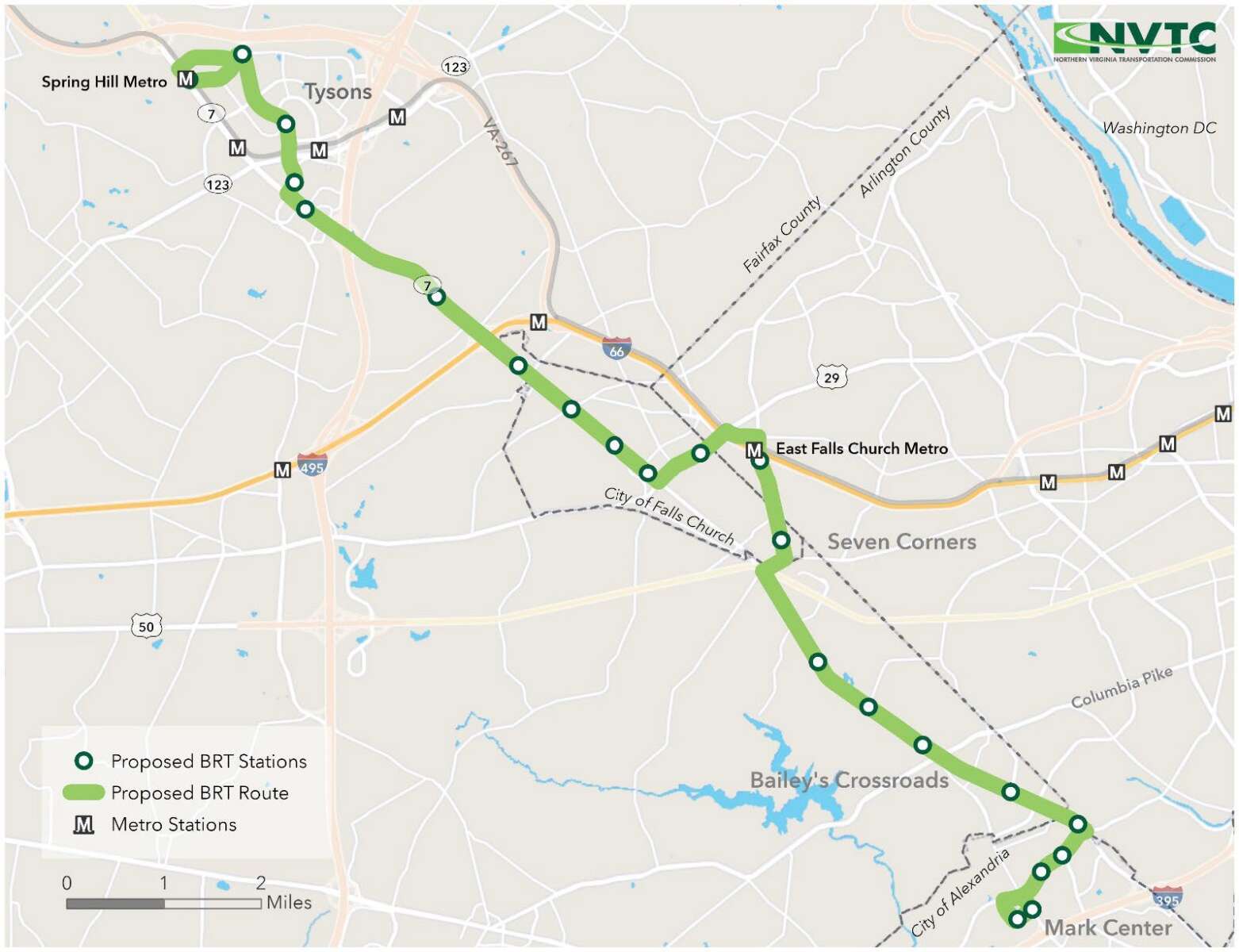
A new bus rapid transit (BRT) route could connect Alexandria and Tysons, and the golden spike in that project could be Falls Church.
The Northern Virginia Transportation Commission (NVTC) is reviewing a study of Envision Route 7’s impact on Falls Church. The study doesn’t make recommendations but provides analysis on how BRT might impact bus and car traffic in Falls Church.
According to the NVTC agenda:
The Commission will be asked to accept the findings of the Envision Route 7 Phase 4-1 Mobility Study, a key element of the fourth phase of planning for a Bus Rapid Transit (BRT) system designed to connect the Mark Center in Alexandria to Tysons via Bailey’s Crossroads, Seven Corners and Falls Church along the Route 7 corridor.
The study included a variety of scenarios for how the BRT route could run through Falls Church, from a “no-build” option to full transit lanes, along with various “hybrids” inbetween.
Unsurprisingly, the scenarios with the higher number of dedicated bus lanes having the largest travel time decrease for buses, though travel times would also increase for cars and other vehicles.
The study also included feedback from public engagement, which determined 60% of respondents agreed improving bus speed and reliability was a high priority, though there was also concern about how the changes might impact bicyclist safety.
The full report is available online.
NVTC is working with Falls Church throughout this fall to develop a preferred scenario, with the project going to various boards and commissions in Falls Church, Fairfax, Alexandria and Arlington this winter.
Image via NVTC/Twitter
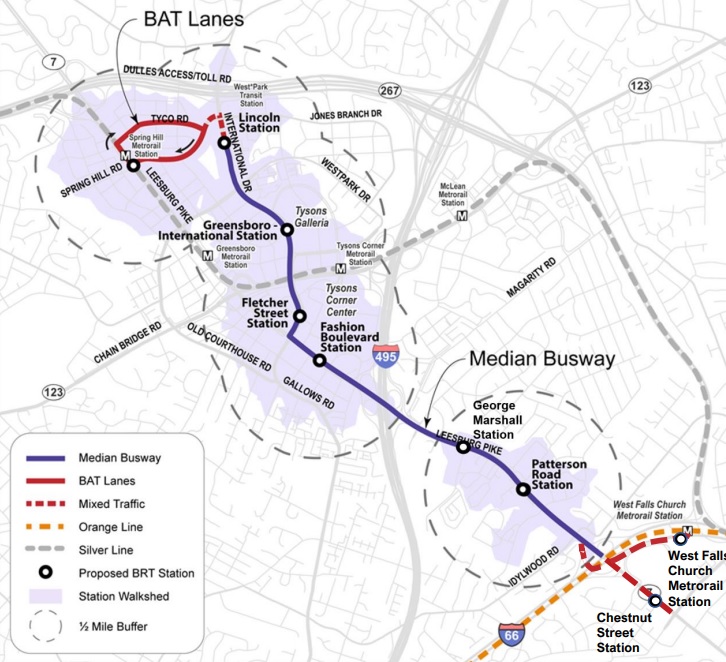
Whenever Route 7 (Leesburg Pike) gets widened, the new lanes from International Drive in Tysons down to the West Falls Church Metro station area will be reserved exclusively for a future bus rapid transit (BRT) system.
The Fairfax County Board of Supervisors approved a comprehensive plan amendment last Tuesday (July 25) incorporating the BRT into the county’s vision for Route 7 and International Drive, a move that enables county staff to pursue funding.
“I do think this is an important movement forward in this project,” Providence District Supervisor Dalia Palchik said after a public hearing.
The Tysons portion of the Route 7 BRT — which is intended to provide faster, more direct service than a traditional local bus route — is part of a regional system that the Northern Virginia Transportation Commission has been planning for a decade now. The finished route will extend into Falls Church City and Seven Corners, ending at the Mark Center in Alexandria.
For the initial Tysons phase, though, the Fairfax County Department of Transportation has settled on the West Falls Church Metro as the southern endpoint and the Spring Hill Metro station as the northern terminus.
Adhering to an alignment approved by the Board of Supervisors in 2021, the BRT will have nine stops:
- The West Falls Church Metro station
- Westbound Route 7 (Leesburg Pike) at Chestnut Street
- Patterson Road, near the Tysons Station and Idylwood Plaza shopping centers
- George C. Marshall Drive
- Fashion Blvd, serving Tysons Corner Center
- International Drive and Fletcher Street
- International and Greensboro Drive, next to Tysons Galleria
- International and Lincoln Circle, near the Rotunda Condominiums
- Spring Hill Metro station
Along with establishing the potential stations, the newly approved amendment designates two additional lanes planned for Route 7 from Haycock Road to International Drive as dedicated BRT lanes.
The comprehensive plan recommends expanding Leesburg Pike from four to six lanes between Haycock and the Capital Beltway (I-495) and from six to eight lanes between the Beltway and Route 123. Funds have already been secured to design the Beltway to Route 123 segment. Read More
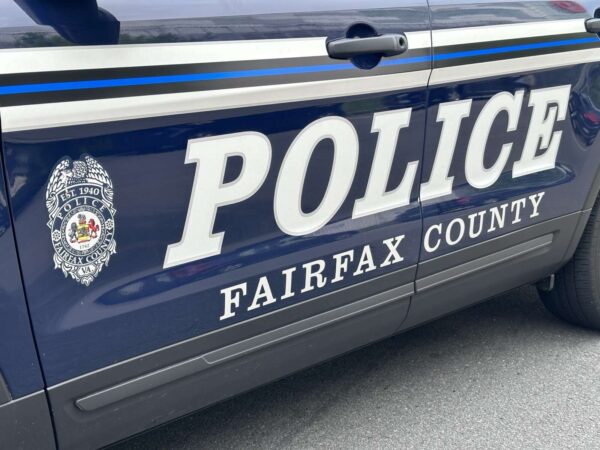
(Updated at 4:30 p.m.) Local police have made an arrest in connection with the robbery of a 66-year-old woman in the vicinity of the North Shore pool.
Police arrested and charged the 38-year-old Reston resident with robbery on Wednesday (July 26).
The incident happened at 8:20 p.m. on Monday (July 24) near a Metro bus in the 11000 block of North Shore Drive.
“The victim was on a Metro bus near the Hunter Woods shopping center,” police said.
The victim reportedly left the bus, where she was conversing with the female suspect, and sat down on a bench.
Police believe the suspect sat down next to her and took her wallet.
“A physical struggle occurred between the victim and a suspect, at which time the suspect ran from the scene and was not located,” the Fairfax County Police Department said.
No injuries were reported.
The suspect is being held on no bond.
Correction: This story previously said the robbery occurred near the Hunters Woods Village Center. The police news release suggests that the victim was riding the bus near that shopping center, but the actual incident took place roughly three miles away on North Shore Drive.
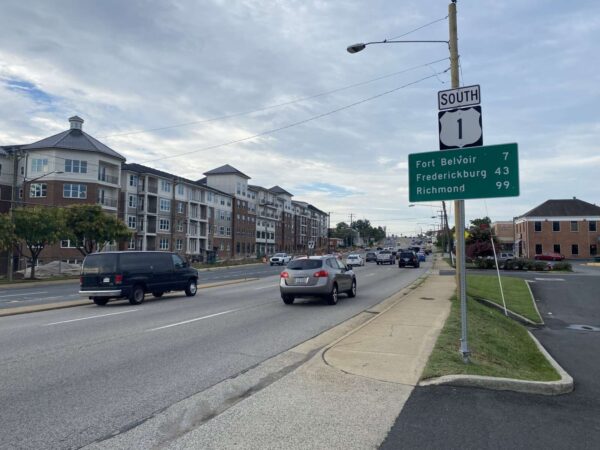
(Updated 10:55 a.m. on 7/26/2023) The ongoing redevelopment of Richmond Highway (Route 1) in Fairfax County has sparked a larger discussion over whether the benefits of road widening projects outweigh their potential harm.
The Virginia Department of Transportation plans to bring improvements to a three-mile stretch in the Richmond Highway corridor in two phases: first from Jeff Todd Way to just north of Frye Road, then from just north of Frye Road to Sherwood Hall Lane.
Notably, the changes will widen Richmond Highway from four to six lanes, which will pave the way for bus rapid transit in the corridor but has garnered some pushback from local community members.
The Coalition for Smarter Growth, which advocates for more “sustainable” transportation methods such as walking, biking and transit in the D.C. region, claimed in a recent press release that “wider roads fail, and the public knows this.”
CSG’s Northern Virginia Advocacy Manager Sonya Breehey says road widening projects create induced demand, arguing that adding more travel lanes incentivizes more people to drive and increases congestion in the long run, despite offering short-term relief.
“The idea is, we get stuck in traffic, so we add travel lanes,” Breehey said. “It’s easy for a few years, but then those travel lanes fill back up and then everybody’s clamoring again for more road widening. It’s a cyclical problem.”
Rep. Don Beyer, who represents the county’s Route 1 area in Congress, told FFXnow in an exclusive interview that he supports road widening projects.
“I think [road widening projects] are an important part of congestion relief,” Beyer said. “There’s an alternative argument…that they will fill up as fast as you build them. That’s certainly been largely true in the metro D.C. area for a long time…but at the same time, I don’t know if it’s still true today.”
In addition to adding travel lanes, the Richmond Highway project reserves median space for future lanes dedicated to The One, a bus rapid transit system that aims to outpace traditional bus services with dedicated lanes and fewer stops.
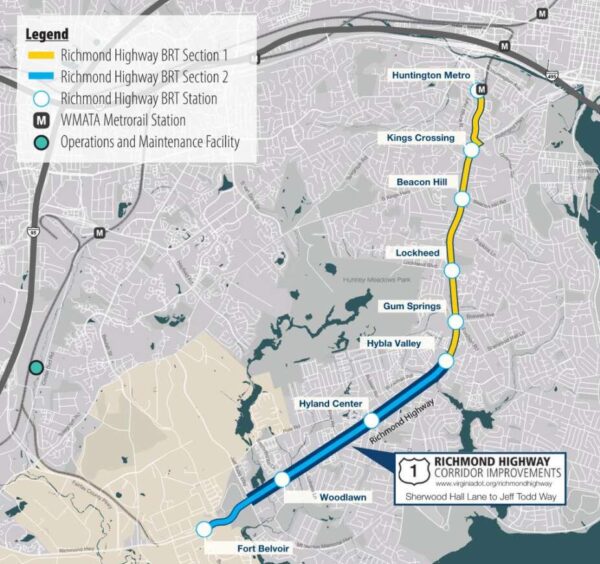
With the BRT expected to be operational in 2030, the Northern Virginia Transportation Commission announced last month that the Commonwealth Transportation Board approved $10 million to help implement the bus system from Fort Belvoir to the Huntington Metro station.
“This billion-dollar investment in a new state-of-the-art transportation system and in the communities along Richmond Highway will revitalize the area and provide more safe, convenient and dependable transportation options for the people who live here,” Mount Vernon District Supervisor Dan Storck wrote in a statement.
Storck says road widening can only be “done right” if it is “in coordination” with “walkable, bikeable communities and mass transit.” Read More

